
SANCTUARY OF THE MADONNA DELLE GRAZIE (OUR LADY OF GRACES)
Travelling from Colbertaldo di Vidor on the road to San Giovanni and Valdobbiadene on the left of via Grazie you come to the Sanctuary of the Madonna delle Grazie, surrounded by hills. It is said that from around 1346 to 1353, to escape from the spread of the black death, a number of friars retreated to these hills for the clean air and to put themselves under the protection of Mary, whose image, perhaps even the very fresco we see today, was worshipped in a shrine. Neither the friars nor the locals were infected by the terrible disease.
VALDOBBIADENE
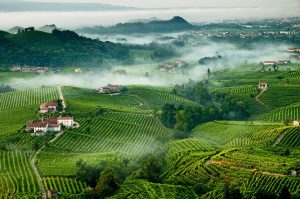
Situated at the foot of wooded mountains, nestling among vine-covered hills, Valdobbiadene owes its name to Duplavilis (possibly meaning two branches of the Piave-Plavis). The first documentary evidence of Valdobbiadene as an organized religious community dates back to 1116 when the Holy Roman Emperor Henry V, in order to protect the lords of Duplavilis who had asked for his assistance, delimited the boundaries of the territory that rightfully belonged to the Duplavinenses. After feudal struggles, in the centuries that followed, Valdobbiadene came under the control of Venice; with the fall of the Serenissima in 1797, under the Treaty of Campo Formio, Valdobbiadene, together with the Veneto, was ceded by Napoleon to the Austrians. With the Unification of Italy, the bourgeoisie of merchants, notaries and Valdobbiadenese landowners who had acquired the lands belonging to the Venetian nobility, built palaces and villas that still can be admired today: Villa Piva, known as the Villa dei Cedri (that is of the cedars), toasted every autumn with bubbly Prosecco, Villa Baberina Arten Viansson, and Villa Barbon Bennicelli, in the hamlet of San Vito.
During the First World War, the current town hall was occupied by the Austrian Command, and the territory was the target of heavy bombing. With the reconstruction at the end of the Second World War, came the development of the cultivation of vines, which through the combination of the work of vine growers and the know-how of the “G.B. Cerletti” wine school at Conegliano, has been instrumental in the success of Prosecco di Valdobbiadene. In the main square of Valdobbiadene you can admire the cathedral, begun in 1798 and consecrated in 1816, with its colonnaded portico with Doric columns in the neoclassical style, in harmony with the tower built in 1767. Inside you can see a magnificent baroque altar in Carrara marble with green (verde antico) inlays in Africano marble; notable are the altarpiece with the ‘Assumption of the Virgin’ by Francesco da Conegliano, known as Beccaruzzi, and that depicting ‘Saints Rocco and Sebastian with the Virgin and a Little Angel’ painted by Paris Bordone during the sixteenth century. The work above the interior entrance doorway is by Ridolfi (sixteenth century), and depicts the dispute of Jesus among the doctors in the temple.
In 1540 the dean of the cathedral was Pietro Bembo, the humanist scholar who influenced the development of the Italian language that is still spoken today, and who was nominated as cardinal and ordained a priest in 1539 at the age of 69. Along the road to Fener is the church of Saint Gregory the Great, a Benedictine pope who died in 604. The church was probably built by the Benedictine Abbey of Santa Bona (Vidor) which owned the land. The remains of the first tiny church from the early thirteenth century are found in the side chapel to the east; after falling into neglect it was rebuilt in the early 1600s and until 1769 was used by Capuchin friars.
The square of Valdobbiadene is dominated by the church of San Florian. First documented in a will dated 1424, it was totally rebuilt in 1724 and completed with the tower bell. After the wartime bombings of 1917-18 it was rebuilt, enlarged and the square in front of it was created, from which you can enjoy the view of Valdobbiadene. After the Second World War the chapel was added to the west to keep a vow.
Continuing along the road towards Vittorio Veneto you get to the hamlet of San Pietro Barbozza, characterized by small clusters of houses grouped around closed courtyards, which lies in the midst of chestnut forests that alternate with sunny meadows and steep valleys.
Proceeding along via Cal Vecchia del Col you come to the shrine dedicated to St. John the Baptist known as St. John of the Locusts, built to ward off the plague of locusts that had caused famine in 1680. During the restoration works of 1993 a valuable fresco was revealed “Madonna and Child with St. John the Baptist and St. Peter”, attributed to the painter Marco da Mel, son of Antonio Rosso who is said to have been the first teacher of the great master Titian.
The wine cellar of Casa Brunoro in San Pietro di Barbozza is home to the headquarters of the Brotherhood of Prosecco founded in 1945, chaired by the Grand Master and with members who are scholars, producers and important figures in the wine world. A Latin inscription “hac ad cellam vinariam descensus/cave ne incertus ascendas” warns: those who safely descend these steps, be careful not to stumble climbing up.
Taking the Barbozza road one comes to the small church dedicated to the Saints Victor and Corona. First documented in 1488, it dates back even earlier, with traces of a Deposition attributed to the Giotto school on its façade. In 1503 a certain Giovanni Gatto who lived close to the church, seeing as how the sound of the bells of St. Peter’s couldn’t be heard there, obtained permission from the bishop to hang a bell in a suitable place in order to recite the morning and evening Hail Mary prayers to the Virgin.
Continuing further we reach the small church of St. Anthony of Padua built in 1797, the year of the fall of the Venetian Republic, at the behest of Geronazzo family, known as Noni. The building was restored, decorated with stained glass windows, and a working sundial by Bepi Mionetto representing farming activities. On the left, just after the church of St. Anthony, is the Corte Geronazzo with an interesting portico with Corinthian columns, while on the façade of the palace you can admire a sundial painted by local artist Pietro Mora in 1775 as testified by the inscription above it.
Taking the road on the right we reach the Hermitage of Saint Albert, an ancient place of worship where even today during Rogation Days for Good Harvests, the rite of the blessing of water is still performed.
The first historical records of the hermitage go back to 1488 when Bishop Barozzi forbade the celebration of Holy Mass because of the precarious state of the building. It would then become a shelter for animals.
In 1706 restoration works were carried out by the hermit Giuseppe Pilla, who also prepared his own tombstone, clearly visible inside the church. In 1864 the choir was added, as were the bell tower and bell, untouched by war, and which can still be heard to this day. Near the church is the house of the hermits, which after the restoration work, has become a destination for continuous stays.
L’OSTERIA SENZ’OSTE

L’osteria senz’oste is a magical place that is nestled in the beautiful hills of the town of Valdobbiadene (TV); a place to be “experienced” with passion, where you can enjoy the stunning landscape in every season and at all hours and where you can eat simple yet high quality foods.
The innkeeper (l’oste), as the name of the place suggests, is not there (senz’oste); everyone who comes to this inn serves themselves choosing whatever they like from the racks, shelves and refrigerators. Then you pay at the end, by referring to a price list and putting the money into a container / moneybox that serves as a cash register.
TOWERS OF CREDAZZO – FARRA DI SOLIGO
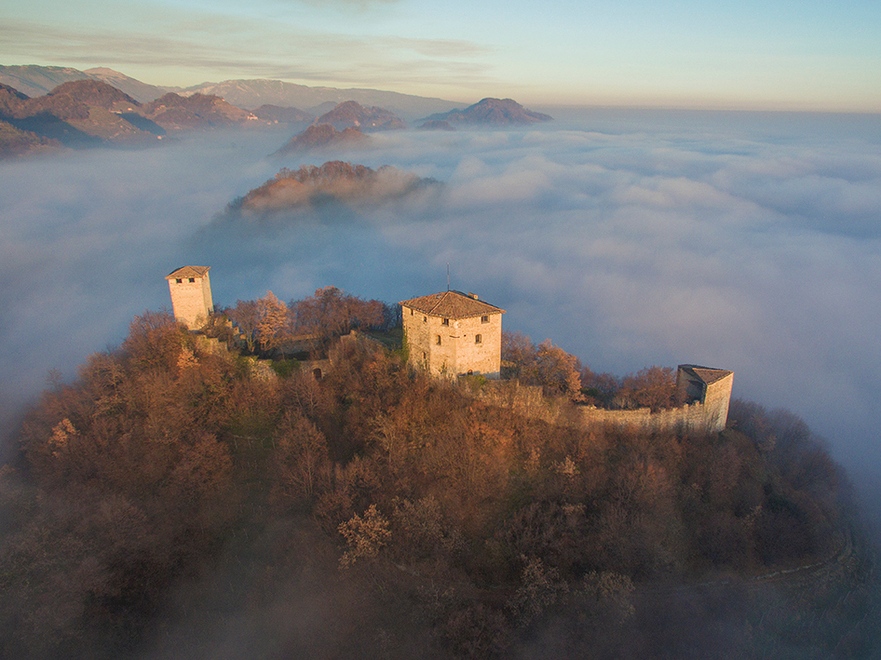
On the way to Conegliano between Farra and Col San Martino, rise the Towers of Credazzo, the remains of Credazzo Castle (from “credaz” – clay, possibly referring to the clay of the surrounding hills) a Collalto estate since the tenth century and enlarged in the thirteenth century, which was most certainly rebuilt on the ruins of older buildings destroyed by the barbarian invasions of the Lombards, Huns and Hungarians (Farra is a Lombardic name). The first documentation using the name of Credazzo dates to before 1233, by which time the fortress had long been under the control of the Da Camino family and was at the centre of a small fiefdom which also included the village of Credazzo (the ancient Villa Credacii) and the beautiful church of San Vigilio. The latter was built between the eleventh and twelfth centuries in a splendid panoramic position and later dedicated to San Vigilio. It was enlarged in the fifteenth century and the interior was decorated with frescoes, while the sixteenth century saw the addition of the apse and the bell tower.
FOLLINA
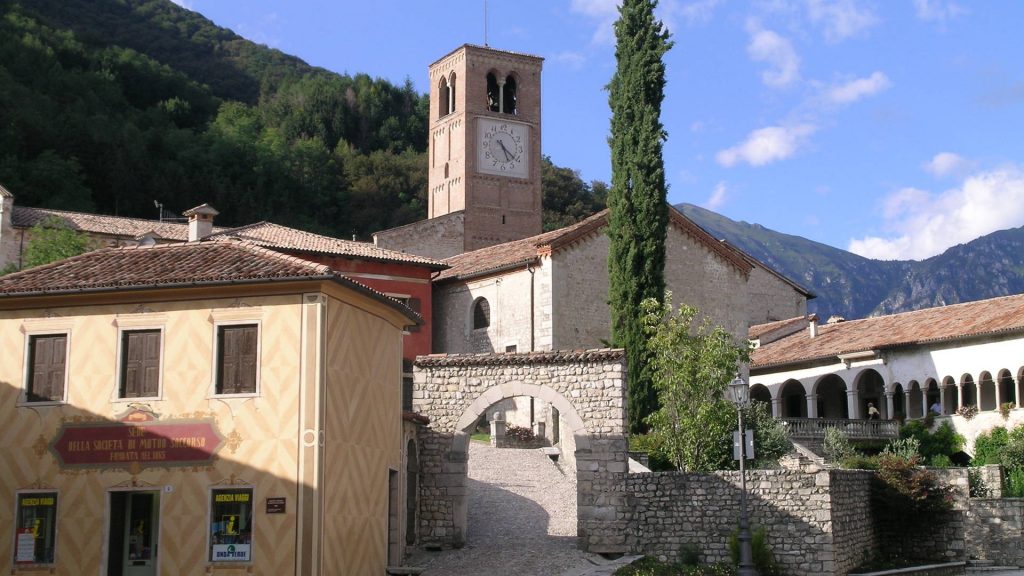
The Cistercian Abbey of Santa Maria in Follina is one of the most famous monuments in the Veneto Region. The abbey, known as the Abbey of Sanavalle (Valsana being the name of the valley) or Follina, was founded on the site of an earlier Benedictine building in 1146 by Cistercian monks sent there by St. Bernard of Clairvaux. The present church has the typical construction of a Latin cross ground plan with the façade facing west and the apse facing east following Cistercian symbolism. Inside the basilica some valuable works are worth mentioning: the large wooden table in the neo-Gothic style built by Venetian masters in 1921, a perfect copy of the original found in the church of San Zaccaria in Venice. The basilica also includes the sandstone statue of Our Lady of the Holy Chalice, thought by some to originate from Nubia in the sixth century, the fresco “Madonna with Child and Saints” painted in 1527 by Francesco da Milano, and a remarkable wooden crucifix from the Baroque period.
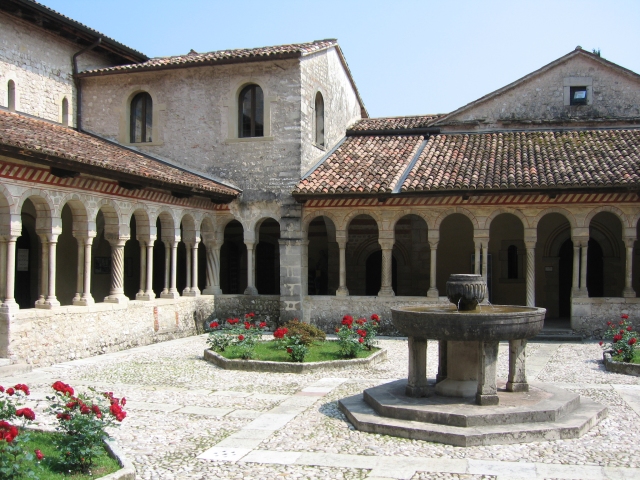
The splendid cloister, earlier in date than the basilica and perfectly preserved, was completed in 1268 when the Cistercian monks settled in the monastery. A plaque in Gothic letters shows the date and the names of the builders of the cloister (the monks Arnaldo and Andrea and the magistros – master builders Zardino and Armano) onto which the most important rooms of the abbey look out: the chapter house, refectory, library and the parlatorio. At the centre, a traditional fountain is found with a monolithic basin. The arches are supported by pairs of single columns, and at the corners, four bundled columns. The shafts are twisted, herringbone, smooth, undulating, papyrus-style or with lotus flower decorations, while the capitals are geometric, naturalistic or symbolic. The Romanesque-style bell tower with a square ground plan is the oldest artefact in the architectural complex of the abbey, and an elegant Chiostrino dell’Abate (Abbot’s Cloister) and loggia from the sixteenth century are also worthy of note. After 1448, with the suppression of the Cistercians, the monastery became a Commendatory Abbey. Among the more famous Commendatory Abbots we find people such as: Pietro Barbo (in 1455) who later became Pope Paul II and St. Charles Borromeo (in 1560). In 1578 the Abbey passed to the Camaldolese monks until its suppression in 1771. The present basilica was built between 1308 and 1338 and was consecrated on 10 October, 1474, and is dedicated to the Annunciation.
CISON
Cison was founded by the Romans as a military camp. When the Cistercian monks arrived in the valley in 1146 they drained the marshes and began working with wool. In 1236 Cison belonged to the Da Camino family who put their castles, including that of Cison, under the protection of Emperor Frederick II swearing loyalty to his imperial vicar Ezzelino da Romano. In 1436 the Republic of Venice gave the castle and the county of Valmareno to the captains of fortune Erasmo da Narni, known as Gattamelata, and Brandolino da Bagnacavallo who, three years later, bought Gattamelata’s share for 3 thousand ducats. In 1797, with the fall of the Serenissima thanks to Napoleon, the Brandolini nobles lost Valmareno.
In the historic centre of Cison, Piazza Roma is overlooked by Palazzo Barbi, the Venetian villa now used as the town hall, and the Loggia, built in the mid-seventeenth century as a courthouse and which is now a theatre. The archpriest church of Santa Maria Assunta is an eighteenth-century gem with a double façade. The single nave interior preserves on the central wall behind the altar, ‘The Assumption of the Virgin’ by Egidio Dall’Oglio (1753) and a valuable organ by Gaetano Callido from 1779. Of particular note are the sculpted angels of the altar, and eighteenth-century paintings by a student of Piazzetta. Outside, the square is further enhanced by the other Venetian palaces. In the historic centre, almost all the shutters on the houses are painted red (a colour known as “Brandolini red”) or brown. It is enchanting to stroll down streets such as Calata, with its dry stone wall, which follows a stretch of the old Roman road Via Claudia Augusta.
Following a fork in the road that runs beside the Rujo river you will reach the Bosco delle Penne Mozze (Forest of Broken Feathers). Opened on 8 October, 1972, it covers an area of over 16,000 square meters of land to “remember with a tree and a stele all the fallen Alpini soldiers born in the province of Treviso.” The trees planted, the paths dedicated to Alpini troops from Treviso awarded the Gold Medal of Military Valour, and over 2,000 steles made by the sculptor Simon Benetton, commemorate the Alpini from Treviso who died for their homeland. Since 2001, the forest began including other Alpini sections of Italy and has now become a place of remembrance for members of the Alpini Corp from the whole country. Continuing beside the Rujo and crossing through the forest one reaches some old mills and other hydraulic works.
BRANDOLINI D’ADDA CASTLE
Brandolini d’Adda Castle is situated in a dramatic position overlooking Cison. The twelfth-century fortified complex consists of various other structures from different periods. The Brandolini owned the castle for 500 years, expanded it and carried out many renovations.
The elegant façade adorned with a double order of mullioned and three-mullioned windows, as well as the park with a fountain, were added at the behest of Count Antonio Maria Brandolini, who died in 1530. The theatre, however, was built in 1683.
In the eighteenth century, the architect Ottavio Scotti built a huge royal staircase, rooms and halls adorned with decorations, and predisposed the private apartments for guests and servants, the stables, the lemon house, the lodgings for the garrison along with shelters for carriages and service warehouses. The small church of San Martino was built on the site of an existing medieval church, full of stucco art works and frescoes by Cison-born Egidio Dall’Oglio, a student of Piazzetta. During the First World War the castle became a military hospital and was badly damaged due to a fire. In 1929, after restoration, it was used as a family residence once more. In 1959 the property passed from the Brandolini family into the hands of the Salesian Fathers who transformed it into a centre of culture and spirituality. Today it is the Castel Brando Hotel.
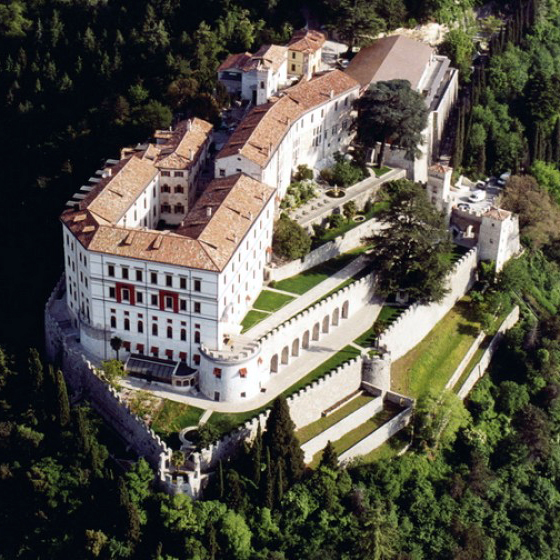
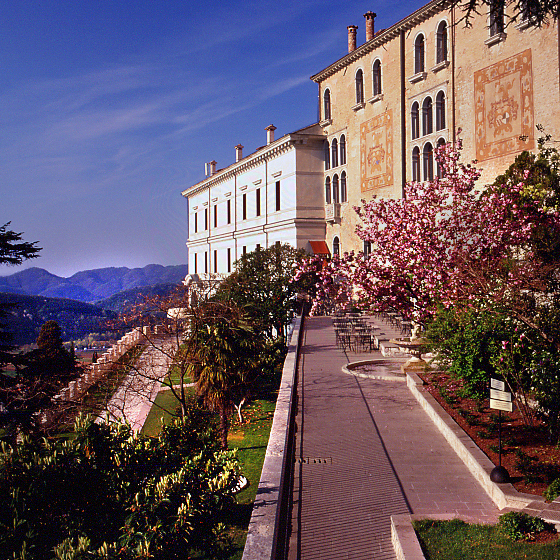
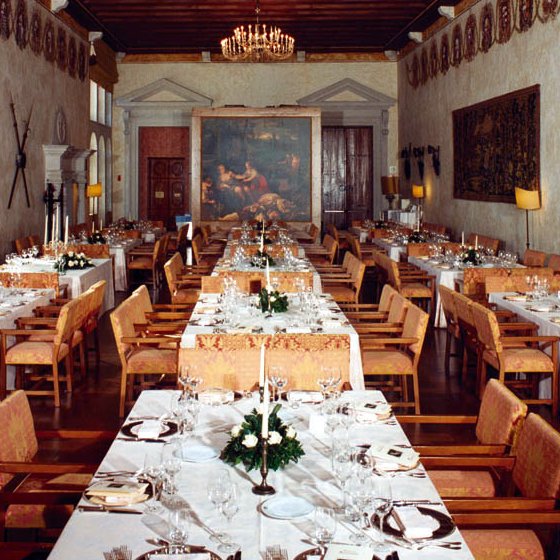
S.PIETRO DI FELETTO
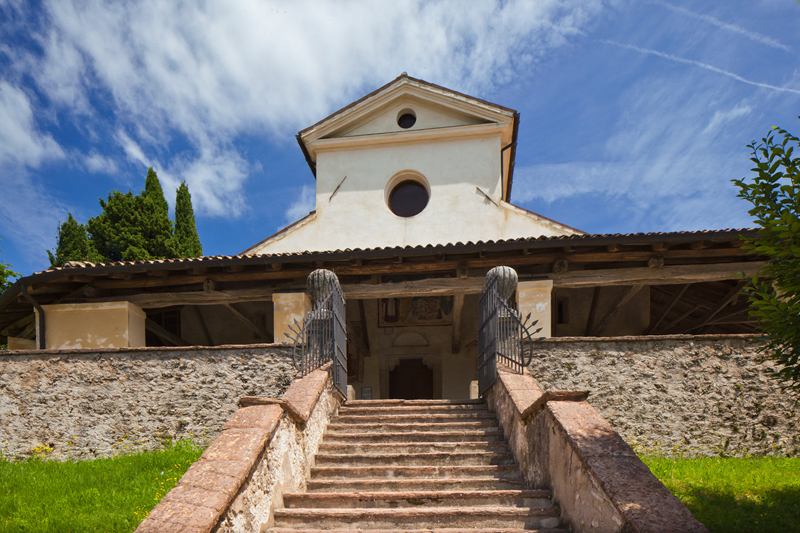
San Pietro di Feletto, is located just beyond the hills of Conegliano and is easily reached along the ‘Strada del Prosecco’ setting out from Conegliano.
The Pieve (Pleban) church of San Pietro, dating back to the Lombard period, was built during the eleventh century. The isolated bell tower, with its sixteenth-century spire, is in the Romanesque style. The wide external porch is decorated with frescoes including the famous “Sunday Christ”, and “Madonna and Child with Saints” in which the baby Jesus suckles milk from a bladder perhaps as was once the custom of poor families. Inside there are three narrow aisles divided by round arches on large, rectangular pillars, opening at the end into a semi-circular apse with paintings stacked in layers. The walls of the nave are entirely frescoed with works by various artists ranging from the thirteenth to the fifteenth century, on the left-hand wall Byzantine-inspired frescoes from the 1200s and 1300s representing Saint Peter, the Crucifixion and stories of the Nativity, and a remarkably imposing figure of Saint Christopher that remains unfinished. In the chapel of the baptismal font there are some late fifteenth-century frescoes illustrating the life and martyrdom of Saint Sebastian. The apse features a Christ Pantocrator (Christ the Almighty). The main altar is Baroque.

The important fresco teaches us that Sunday is not a day of work: those who work on Lord’s day hurt Christ who is pictured with blood pouring from wounds caused by work tools. The painting shows us the tools and types of work of the past.

Above the main entrance Saint Anthony the Abbot, Saint James, the Madonna and Child and a bishop.

On the left Saint Anthony the Abbot and the “Madonna del Latte” (“Nursing Madonna”).
VITTORIO VENETO
Vittorio Veneto was founded on 27 September, 1866 by the union of the towns of Ceneda and Serravalle, and took the name of “Vittorio” in honour of Vittorio Emanuele, the first king of Italy. The “Veneto” moniker, began to be used increasingly after the battle that ended the hostilities between Italy and Austria at the end of the First World War. Even today the city continues to demonstrate a certain bipolarity.
Of particular interest is the Cathedral in Serravalle, dedicated to Santa Maria Nova, which was erected in the early fourteenth century and then rebuilt in 1776. It houses the Titian altarpiece depicting the ‘Madonna and Child in Glory and with Saints Andrew and Peter’. The Church of Saint John the Baptist was built in the fourteenth century and contains fifteenth-century frescoes: four organ doors painted by Francesco Frigimelica the Elder and the Baptism of Christ by Francesco da Milano.
The church of Santa Giustina built in 1227, was dependent on the Abbey of Follina, then ceded to the Benedictines of Padua. The building is a national monument and was almost completely rebuilt at the end of the sixteenth century. Inside is the tomb of the last nobleman of Serravalle, Rizzardo III, before the arrival of the Venetians.
The fifteenth-century church of San Lorenzo dei Battuti, recognized in 2015 by the Touring Club as one of the hidden gems of Italy, is nestled between the fourteenth-century Scuola dei Battuti (the self-flagellation brotherhood) and the Clock Tower. The interior is entirely covered with frescoes realized during about the first half of the fifteenth century by different artists related to the so-called “Gothic devotional painting” style.
It is the oldest church in Vittorio Veneto and was the mother church of Serravalle before the construction of the cathedral. It was nominated for the first time in 1224, rebuilt in the Romanesque style, consecrated in 1303 and again in 1486. The splendid interior decorations from the fifteenth and sixteenth centuries are the work of local artists Antonio Zago, Iseppo da Cividale and Francesco da Milano.
The slopes of Monte Marcantone are a place of secular worship and home to the relics of the patron saint of Serravalle Santa Augusta.
Piazza Marcantonio Flaminio, dedicated to the famous humanist from Serravalle, is the result of a remarkable sixteen-century redesign and further alterations during the nineteenth century. Its regular shape and the paving in Istrian stone stand out particularly. The square is surrounded by Renaissance palaces such as the Palazzo della Comunità (or Loggia di Serravalle), ancient seat of local government rebuilt in the middle of the fifteenth century and currently housing the Museum of Cenedese, with displays of Roman and medieval archaeological finds.
The streets of Serravalle are embellished with numerous secular façades of great historical and architectural importance.

The eastern side of Piazza Flaminio: the Civic Tower and on the right, the Palazzo della Comunità.
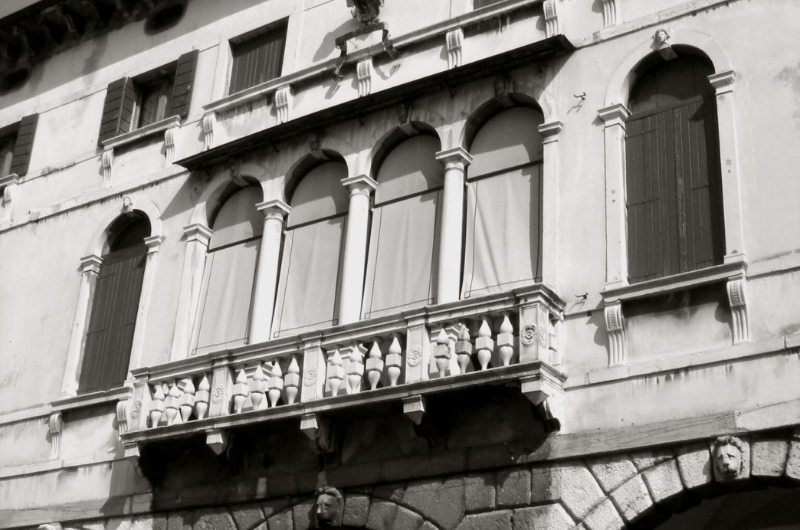
Palazzo Minucci De Carlo, detail of the façade. It is worth visiting The Museum of the Battle of Vittorio Veneto that with modern technology and through different sections (the trenches, the armoury, the occupation, from the Battle to the myth) allows you to discover testimonies of the Great War that ended right here in Vittorio Veneto.
SCHOOL OF OENOLOGY IN CONEGLIANO
After over a century of wine production in the hills of Conegliano-Valdobbiadene, it was during the second half of the nineteenth century that the modern wine-growing adventure began with a variety of vine and a wine that would prevail in the second half of the twentieth century.
Wine producers contributed significantly to this success with the help of institutions. First and foremost the School of Viticulture and Oenology in Conegliano founded in 1876 thanks to the initiative of Antonio Carpenè with the collaboration of Giovanni Battista Cerletti. The school has been the driving force behind the oenological development of the surrounding area and throughout Italy as a whole, thanks to teachers with highly respected international reputations such as Arturo Marescalchi (Under Secretary of Agriculture), Giovanni Dalmasso (director of the University of Turin Department of Agriculture) and Luigi Manzoni (the creator of famous hybrids).
After the First World War and the advent of the first vine diseases (powdery mildew, phylloxera, downy mildew) viticulture around Treviso was severely impacted. This prompted teachers and the most dynamic producers to found a new institution dedicated to scientific research. The “Experimental Station of Viticulture and Oenology” opened in 1923 in Conegliano with director G. Dalmasso and with the collaboration of Italo Cosmo (who would later breed a Prosecco clone) and Giuseppe Dall’Olio. Thanks to these two institutions after the Second World War, the Conegliano-Valdobbiadene area managed to fully realise its potential.
In this period, some of the most discerning tenants and sparkling wine producers from Valdobbiadene organized themselves to defend and promote the hillside vines and oenology, while it also became apparent that there was a need to define the legislative aspects related to viticulture and oenology to improve quality and protect the typicality and characteristics of Prosecco. Thus, on 7 June, 1962 the “Consorzio per la tutela del vino Prosecco di Conegliano e Valdobbiadene” (Consortium for the protection of Prosecco from Conegliano and Valdobbiadene) was founded. The results of this commitment to protection and promotion were immediately obvious, so much so that in 1963 Valdobbiadene was officially declared the capital of Prosecco and the whole of the Italian sparkling wine world thanks to the “National Exhibition of sparkling wines”, which was held every year at the “Villa dei Cedri” in Valdobbiadene.
The determination of winemakers achieved further success in 1969 when Prosecco was awarded “Denomination of Origin” status (Prosecco DOC di Conegliano and Valdobbiadene). In recent years Prosecco has become the most popular white wine in Italy and worldwide.
Its fabulous success, combined with the perseverance and professionalism of the producers, led to Prosecco receiving its final and most prestigious award, the “Denomination of Controlled and Guaranteed Origin” status, thus since 1 April, 2010 it has been legally classified as Conegliano Valdobbiadene Prosecco Superiore DOCG. In 1968, with the founding of the Wine Society, work began in Conegliano on the research of various types of Prosecco that were already being cultivated in the hills of Conegliano and Valdobbiadene.
CONEGLIANO
Many sacred buildings are preserved here:
- The façade of the cathedral is covered by the elegant structure with pointed arches of the Scuola dei Battuti, decorated with important frescoes by Pozzoserrato on the façade and the interior of the hall. Inside the cathedral you can admire the only work by Cima da Conegliano found in his home town: the Conegliano altarpiece from 1492, located behind the main altar. Also worthy of note is the painting by Palma il Giovane placed over the doorway that depicts Saint Catherine baptised by the hermit.
- The seventeenth-century church of San Martino: the former headquarters of the Dominican monks is one of the largest religious buildings.
- The twelfth-century church of Saint Ursula: the small church that stands next to the castle.
- The church of Saints Rocco and Dominic (seventeenth century): located in the heart of the city, it has an important twentieth-century façade.
- The streets of the medieval historic centre wind their way up Colle di Giano along Via XX Settembre, the ancient Contrada Granda, to the top of the hill to the Civic Museum housed in what remains of the medieval castle.
CASTELLO DI SAN SALVATORE

The Castello San Salvatore overlooks the village of Susegana and its history is linked to the affairs of its owners, the noble Collalto family, who in 1312 obtained from the Emperor Henry VII for themselves and their descendants full jurisdiction over the counties of Collalto and San Salvatore. The castle, characteristically late medieval in design, was badly damaged between 1917 and 1918 when, following the Battle of Caporetto, the municipality found itself in the Austro-German occupied territories with the front line along the river Piave.
PORTOBUFFOLÈ
Called Septimum de Liquentia by the Romans (because it was seven miles from Oderzo and positioned near a bend of the river Livenza) it owes its present name to the medieval Latin word “bova” meaning channel, or to the “bufaline” boats used for the transport of goods along the river. In 1300 Gaia da Camino settled in Portobuffolè, immortalized by Dante in Canto XVI of Purgatorio (Purgatory) like her father Gherardo, lord of Treviso. Gaia was the wife of Tolberto da Camino who became lord of Portobuffolè in 1307. Gaia died in 1311, and the second wife of Tolberto went to Venice to ask Doge Dandolo for protection. She returned to the castle only in 1336 and in 1339 Portobuffolè passed to the Venetian Republic. In 1797, after the fall of the Serenissima, Portobuffolè also passed under French rule, and then in 1815 together with the whole of the Veneto was annexed to Austria. On 15 July, 1866 the first troop of Italian soldiers entered the town, and during the First World War in 1918 Porta Trevisana was destroyed by the Austro-Hungarian troops during the retreat.
Once you reach Portobuffolè head towards Piazza Beccaro surrounded by beautiful buildings: Cà Soler with an important façade that at one time looked towards the canal, now below ground, and another building on which there are the remains of frescoes attributed to Pordenone. From the square you can then reach the house in which Gaia da Camino lived until her death in 1311. On the façade the mullioned windows are embellished with slender, elegant columns with lotus flower capitals. The frescoes preserved on the first floor depict a courtly scene enlivened by the songs of minstrels. The interior walls of Casa Gaia are painted with a prince accompanied by a servant, bowed down under the weight of a big book, and six young warriors clad in finely worked armour. A castle, perhaps that of Portobuffolè, can be noted, and two roughly sketched figures who are perhaps the hosts Tolberto and Gaia. On the second floor are depicted fortified cities, drawbridges, towers and palaces, and pages in conversation. Portobuffolè castle had seven towers, but now only the tenth-century Torre Comunale remains, 28 metres high and brick built. There was once an opening in the clock from which the condemned were lowered into the prison below. The house at the foot of the tower was once the Palazzzo del Governo and still bears the inscription: “fatta dalle fondamenta il 9 marzo 1187” (built from the ground up on 9 March 1187). Above the door of the Monte di Pietà (Mount of Piety pawn broking institution), founded in the sixteenth century by the Venetians, there is a rare example of “leon in moeca”, represented with the terrifying appearance used in wartime. The Lion of St. Mark also dominates in Piazza Maggiore where government offices and the palaces owned by the most important families were found. The town hall has a large loggia and elegant oval-arched windows and a large hall, known as the “fontego”, which was used to store grain and salt that was distributed to various parts of the Veneto. The cathedral was consecrated in 1559 and contains a German school wooden crucifix from the fifteenth century, and a splendid organ built by Venetian organ-maker Callido with 472 zinc and tin pipes, which in 1780 cost more than 4,000 Venetian gold lire. During restoration works on the former home of the archisynagogue, next to the cathedral, a stone with the Jewish seven-branched menorah was discovered and some letters of the alphabet. Continuing from the square you then reach the “Toresin” and Porta Friuli, where above the outer arch, a Lion of Saint Mark exalts the “rights and duties of man and citizen”, a remnant of the influence of the French Revolution. Ponte Friuli (Fruili Bridge), built in 1780 in baked stone to replace the wooden drawbridge, has two large arches and is lined by six elegant balconies. Down below flows the river Livenza.
Edited by Prof. Giuseppina Barbato



 DE
DE IT
IT